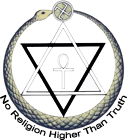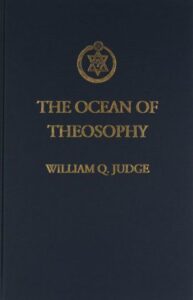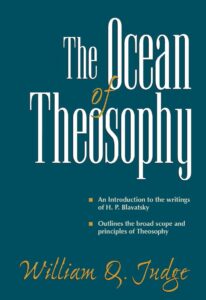Studies In The Ocean of Theosophy Part XXVI
Theosophy Magzine
Vol. 23, No. 12 October 1935
pages 558 - 562
ALTHOUGH the subject of psychism is often touched upon in the “Ocean”, Mr. Judge completes the work by once more elevating a signal of warning against its practices, especially those peculiar to Spiritualism. For, as the Teacher points out, the cycle which had then almost run its course for that century would be followed by another rising tide; and if in the meantime there were “gained some right knowledge of the true philosophy of Man and Nature”, the West might be “ready to bear the lifting of the veil a little more.” But there must be “a reform in morals and philosophy before any great attention will be accorded to the strange and seductive phenomena possible for the inner powers of man.” Today finds that new tide of psychic impulse rising; but has the Western populace earned further lifting of the veil? Is it probable that “those who know all about the psychical world, its denizens and laws”, and who labor to help on the progress of race will aid the opening of our Astral faculties? How could greater powers be fostered in men employing their present abilities to betray, deceive, rob, and slay one another!
“The doctrines given in preceding chapters are those of true spiritualism”, ancient of days; but the cult so inappropriately bearing this name is old, too — as old as human folly. In India it is fittingly designated as “bhuta worship”; for “by it the gross and devilish, or earthly, parts of man are excited, appealed to, and communicated with”, on both sides of death. The Astral corpses contacted are as comprehending as an echo, as intelligent as the reflection in a mirror. Critical analysis of their alleged messages would preclude any possibility of direction by mind or conscience. The few shreds of near-intelligence forthcoming vary with the medium and smack suspiciously of the medium’s particular mental slant.
If popular spiritualistic conceptions were correct, the dwellers in Summerland should have knowledge of both here and there, past, present, and future. Their experiences in those realms of bliss should be at least similar. Every Soul returning to visit the earth should understand exactly how this is done and how his connection with the medium is made. None of that fair company could be untruthful or deceive or pretend to knowledge not possessed, or be puffed up over what he does have. The dead would always uplift the living. Wholesomeness would be wafted on the pure breath of the “spirits”. Happy and blest, the mediumistic link between the two worlds, safeguarded and protected by his divine “controls”.
However, the record of Spiritualism indicates the reverse: the communicants are consistently ignorant; great philosophers, supposedly, uttering “only drivel and merest commonplaces”; others claiming to be “men who lived in older civilizations” showing ignorance thereupon or merely repeating “recently published discoveries” — in case these have been perused by the medium. Also, those happy ones “disagree among themselves” about the conditions of the after-life. The forms appearing in the seance-room waver aimlessly about, seeming not to sense where they are, how they got there, or why they came. The speaking controls have nothing to give as to the “rationale of phenomena nor of development of mediumship”, yet pomposity and the assumption of high-sounding titles is their stock in trade. Their living associates “come to physical and moral grief, are accused of fraud, are shown guilty of trickery”, without interference by the spirit guides “to either prevent or save.” Indeed, the mediums admit that those very controls and guides do sometimes themselves “deceive and incite to fraud.”
In the very few instances when the laws governing any of the phenomena have been correctly stated, the testimony was tabled. Being in direct disagreement with the theories of the cult, it was perhaps feared that the spirits might veto further “sittings”. To the Theosophical student those unwelcome interlopers are of unusual interest, he being by no means devoid of a rational theory concerning their order of being. At least, there is conviction that such are foreign to the hordes of Kama Loka. Evidently the Spiritualists suspected this, too, judging from the promptness of their repudiation.
All things considered, “the man of materialistic science is fortified in his ridicule”, but scarcely justified; for, after eliminating fraud and delusion, there remains a mountain of unexplained facts. Ridicule changes nothing, but is rather the coward’s weapon of defense against that transcending his understanding. Not at all crediting spiritualistic theories, Theosophy still maintains that satisfactory “explanations are to be found in other theories.” Prejudice is a mental flaw: the agriculturist refusing an effective cure for pests in favor of an ineffective method of his own, risks to lose his crop; the physician so addicted to his “pathy” as to scorn investigation of other remedies possibly more efficacious betrays his trust to suffering Humanity; the lawyer rejecting honest evidence in order to “win the case” terribly unbalances the scales of justice. But if all persons and classes afflicted with prejudice were forbidden the right to pass judgment, how many would remain to deride the Spiritualist for clinging to his belief, against the dictates of common-sense!
Addicts to spiritualistic practices should be regarded as psychically ill and treated accordingly. The best prescription for this malady is a mixture of seeds of rational explanation, leaves of sound philosophy, and roots of broad general principles, carefully apportioned and blended, to meet the individual needs. All necessary formulae are to be found in the manual known as The Doctrine of the Seven-fold Nature of Man. Of course, the patient can not be forced into the dispensary. These medicines are not for the unwilling; but many a casual contact might serve to foster willingness, or even stir the sufferer to seek out the cure. Such help is afforded not by denial of the phenomena, nor by contempt for the practice, but by friendly assurance that better explication exists. The reasons underlying the phenomena include the reasons for avoiding them. To perceive the one is to end by perceiving the other.
Nothing is too mysterious to find clarification in the Theosophical doctrines. The only limitation lies in the understanding of the investigator. But the enumeration in chapter seventeen of requirements for a perfect apprehension of “the psychic phenomena found in the history of ‘spiritualism'” indicate that the fullest scope of greatest minds is necessary. No phase of knowledge seems excluded. The summation of these requirements amounts to realization of all forty-nine Fires of Consciousness, their fields of action, and every power, force, process, and law pertaining to them. Who, then, less than an Adept can safely indulge in psychism; and who more than an Adept would sedulously avoid the same! The plain fact is that the more mediumistic phenomena are indulged in, the less can they be understood. Such practitioners “progress” backward. Atavism, not Evolution, is the path they follow — a path of woe, indeed!
The “Astral part of the man is now only normal in action when joined to the body”; the latter being infiltrated into the Astral model for purposes that must be fulfilled here on the physical plane. Ages hence, when those ends have been accomplished, the Astral will again “normally act without a body as it has in the far past”, on its own plane, far removed from the regions of ghosts and ghouls. This fact shows that mediumship is produced by injuring the instrument built up by Nature. It means “to become disorganized physiologically and in the nervous system, because through the latter is the connection between the two worlds.” Through this rift, “the unknown forces rush in” from the grosser part of Nature, which, being nearest to us, “affects us most”. From this follows victimization to “the vile thoughts of all men” and subjection to “the influence of the shells in Kama Loka.”
However pure the original motive of a medium, the door he has torn open is open to all, good or bad. Contact with the motley array thus finding such easy access leads to the terrible dangers and demoralization pictured by Man’s divine Friends, down the ages. If money be taken for the practice, “an additional danger is at hand, for the things of the spirit and those relating to the astral world must not be sold.” Any selfish ends, even mere curiosity, in the attempt to acquire psychic powers incur grave hazards. “Equally improper is the manner of the scientific schools which without a thought for the true nature of man indulge in experiments in hypnotism in which the subjects are injured for life”. “The Lodge of the Masters does not care for Science unless it aims to better man’s state morally as well as physically, and no aid will be given to Science until she looks at man and life from the moral and spiritual side.” Perhaps Science feels that she has no need of Masters’ aid; but, if so, she stays her progress more than she dreams.
Dire as are these various pollutions of the evolutionary stream, their consequences may be even more far-reaching than at first appears. For no action takes place outside of Life; hence, “lives” can act upon nothing save other “lives”. Spiritualistic phenomena are produced by action upon astral and elemental lives, in evolution like every thing else. When these shall have reached the animal grade in the School of Existence, might not the magnetic rapport now set up with them through mediumistic practices sometime, in a future Day, draw the responsible individuals to them in a calamity similar to that of our fourth Round? The degrading and defiling character of the connections established seems to place such a speculation not beyond the pale of possibility, if not of probability; especially as the debacle depicted in chapter fifteen was the perpetuation of a like mistake in a prior period.
Yet, the harmful lines already started could be largely off-set, were the wrong to be recognized and mitigating causes produced. He who has battled on the adverse and destructive side can as valiantly battle on the constructive side. On the field of Kurukshetra all forward movement has to be won by strenuous effort; struggle to regain lost ground is as worthy as any other effort. Even the mental voyage across “The Ocean of Theosophy” is accomplished by seventeen stages, each of which represents a battle against preconceived ideas. In these mighty engagements of the Great War, the chief foes to be overcome are the protean personal-god idea, false self-identification, the one-life basis of evaluation, and straight-line evolution — all, agents of Materialism and employed for its strategy in resistance of Spiritual conquest.
Eventually Spirit shall win. Then Arjuna, the Prince of the Pandus, having entered his kingdom, shall once more dwell secure in the Temple of Solomon lighted by Manas and warmed by Buddhi. Yet looking back over the long, hard march, the Soul-Man may even rejoice that he did once lose his inheritance, for the sake of the strength, wisdom, and compassion acquired in its regaining. For the assistance of exiled Arjunas wandering and confused in the wilderness of matter, Mr. Judge submitted the “Ocean of Theosophy” “to its readers in every part of the world.”
(Conclusion of Series)
COMPILER’S NOTE: The following is a separate item which followed the above article but was on the same page. I felt it was useful to include it here:
“A WARRIOR FOR TRUTH”
Out of the turmoil and the strife of an apparently untamed life may arise one who is a warrior for Truth. A thousand errors of judgment made by an earnest student, who, with a pure and high motive, strives to push on the Cause, are better than the outward goodness of those who are judges of their fellows.
–William Q. Judge
Back to Ocean of Theosophy



